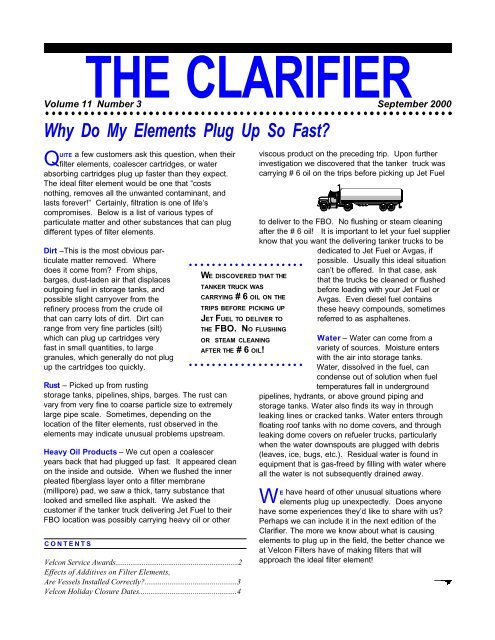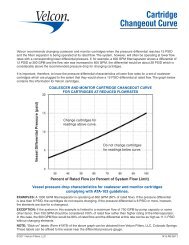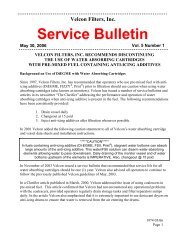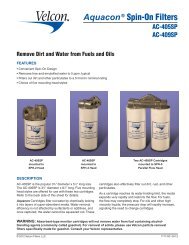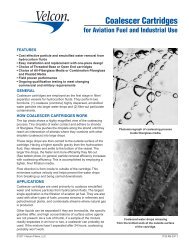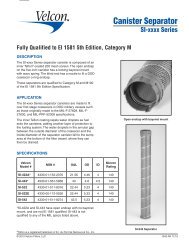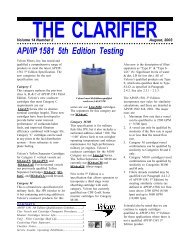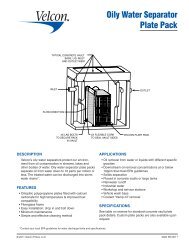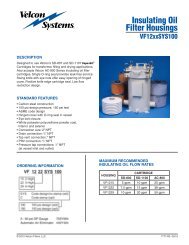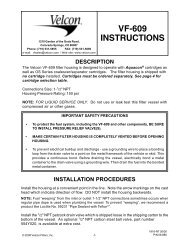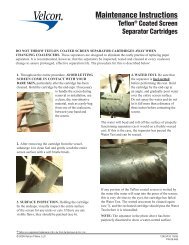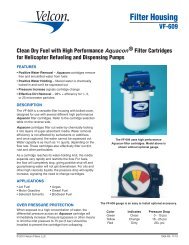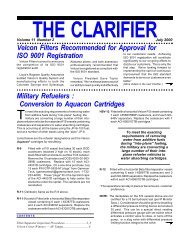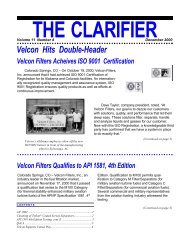Clar0900.pdf - Velcon Filters
Clar0900.pdf - Velcon Filters
Clar0900.pdf - Velcon Filters
Create successful ePaper yourself
Turn your PDF publications into a flip-book with our unique Google optimized e-Paper software.
THEVolume 11 Number 3CLARIFIERSeptemberCONTENTS<strong>Velcon</strong> Service Awards.................................................................2Effects of Additives on Filter Elements,Are Vessels Installed Correctly?................................................3<strong>Velcon</strong> Holiday Closure Dates...................................................42000Why Do My Elements Plug Up So Fast?QUITE a few customers ask this question, when theirfilter elements, coalescer cartridges, or waterabsorbing cartridges plug up faster than they expect.The ideal filter element would be one that “costsnothing, removes all the unwanted contaminant, andlasts forever!” Certainly, filtration is one of life’scompromises. Below is a list of various types ofparticulate matter and other substances that can plugdifferent types of filter elements.Dirt –This is the most obvious particulatematter removed. Wheredoes it come from? From ships,barges, dust-laden air that displacesoutgoing fuel in storage tanks, andpossible slight carryover from therefinery process from the crude oilthat can carry lots of dirt. Dirt canrange from very fine particles (silt)which can plug up cartridges veryfast in small quantities, to largegranules, which generally do not plugup the cartridges too quickly.Rust – Picked up from rustingstorage tanks, pipelines, ships, barges. The rust canvary from very fine to coarse particle size to extremelylarge pipe scale. Sometimes, depending on thelocation of the filter elements, rust observed in theelements may indicate unusual problems upstream.Heavy Oil Products – We cut open a coalesceryears back that had plugged up fast. It appeared cleanon the inside and outside. When we flushed the innerpleated fiberglass layer onto a filter membrane(millipore) pad, we saw a thick, tarry substance thatlooked and smelled like asphalt. We asked thecustomer if the tanker truck delivering Jet Fuel to theirFBO location was possibly carrying heavy oil or otherWE DISCOVERED THAT THETANKER TRUCK WASCARRYING # 6 OIL ON THETRIPS BEFORE PICKING UPJET FUEL TO DELIVER TOTHE FBO. NO FLUSHINGOR STEAM CLEANINGAFTER THE # 6 OIL! .viscous product on the preceding trip. Upon furtherinvestigation we discovered that the tanker truck wascarrying # 6 oil on the trips before picking up Jet Fuelto deliver to the FBO. No flushing or steam cleaningafter the # 6 oil! It is important to let your fuel supplierknow that you want the delivering tanker trucks to bededicated to Jet Fuel or Avgas, ifpossible. Usually this ideal situationcan’t be offered. In that case, askthat the trucks be cleaned or flushedbefore loading with your Jet Fuel orAvgas. Even diesel fuel containsthese heavy compounds, sometimesreferred to as asphaltenes.Water – Water can come from avariety of sources. Moisture enterswith the air into storage tanks.Water, dissolved in the fuel, cancondense out of solution when fueltemperatures fall in undergroundpipelines, hydrants, or above ground piping andstorage tanks. Water also finds its way in throughleaking lines or cracked tanks. Water enters throughfloating roof tanks with no dome covers, and throughleaking dome covers on refueler trucks, particularlywhen the water downspouts are plugged with debris(leaves, ice, bugs, etc.). Residual water is found inequipment that is gas-freed by filling with water whereall the water is not subsequently drained away.WE have heard of other unusual situations whereelements plug up unexpectedly. Does anyonehave some experiences they’d like to share with us?Perhaps we can include it in the next edition of theClarifier. The more we know about what is causingelements to plug up in the field, the better chance weat <strong>Velcon</strong> <strong>Filters</strong> have of making filters that willapproach the ideal filter element!
<strong>Velcon</strong> Service AwardsCarl Brandt: 30 Years with <strong>Velcon</strong>Recently Carl Brandt, Industrial Products Manager, celebrated 30 years of service with <strong>Velcon</strong> <strong>Filters</strong>. We asked himto share some of his <strong>Velcon</strong> memories and experiences with us. Here are his comments.I started work at <strong>Velcon</strong> in thetest lab as a lab tech. The testlab was just a fenced in areatacked to the side of the buildingin San Jose, CA. We had twotank trailers parked on the streetfor fuel storage, in addition to twosmall underground tanks. Whenthe lab supervisor left in 1972, Ibecame the new supervisor. Ithen spent the next 20 years inthis position before becomingIndustrial Product Manager in1992.Qualification tests were alwaysthe most intense and challengingtimes. Years ago, we ran manymilitary qual tests that includedlife tests that ran 24 hours perday.One of my most memorabletimes at <strong>Velcon</strong> was duringdevelopment of an oil/waterseparation system designed tobe used on navy ships to get oilout of bilge water. I monitoredRick Waite Celebrates 25 Years with <strong>Velcon</strong>Some of Rick’s highpoints:• Working with Carl Brandt todraft the revised military monitorspecification (MIL-M-81380C),having it published, and being thefirst company qualified with theCDFs. Carl, Jack Estabrook,Claudia Bell, Rip Taylor, and a lotof others were involved in thebringing of the CDFs to market.• Flying over the glaciers andmountains of Alaska with Linda &Monte Parrish, listening to Enya onthe intercom, and thinking, “This isas good as it gets!” Getting myPrivate Pilot License in ’92 aftercoming back from Alaska.Journeying to the North Slope oilfields with Monte, John Thomas,and Larry Fleming. Alaska is agreat place to visit!!!several successful tests of ourunit while on navy ships at seaduring actual combat exerciseswhere they were firing their largeguns.Work here has been bothinteresting and challenging, andI have always enjoyed thepeople I work with. Maybe thatis why I have been here so long.Rick Waite, Petroleum Products Manager (Aviation Products Manager) for the past 25 years, is also reminiscentof his time here at <strong>Velcon</strong>.Sky How: Another 25 Year Veteran• Visiting with our outlyingmanufacturing plants, customers,and Distributors, and working as a“family of friends” versus the moreformal supplier-customerrelationship.Rick notes, “We have somegreat people in our ‘<strong>Velcon</strong> family!’This is the reason for the 25years, the relationships that havebeen formed.”Sky How, Industrial Engineer in our Alabama manufacturing plant, is also celebrating 25 years with <strong>Velcon</strong>.Sky started with the company asan Industrial Engineer in California25 years ago. When the decisionwas reached to build a plant inAlabama, Sky oversaw theconstruction and basically hadhands-on experience in constucting<strong>Velcon</strong> Alabama, Inc. Hemaintained a position of PlantManager for several years. He alsoaided in the North Carolina plantstart-up.He advised that the high point of hiscareer was and is his involvementwith the plant and watching theCompany expand over the years.Another high point has beenwatching the Alabama plant startout with 5 production employeesand expand to the current numberof over 40 employees.Sky attributes his longevity with theCompany to the workingrelationships with the Plant and withhis involvement in all aspects of thecompany over the years.2
Effects of Additives on Filter ElementsQuestions are occasionally received concerning the effectsvarious additives have on coalescers, separators, monitorcartridges, etc. Based on experience with our laboratory testing,and experience in the field, here is a short summary:Static Dissipator – The previous ASA-3 static dissipator was amild surfactant and dirt disperser. In the normal dosages of 1to 3 ppm, it was relatively easy on coalescers, but over a periodof time we saw coalescers that were being disarmed between1 to 2 years of life. We think this disarming was also associatedwith the dirt buildup in the coalescers. The ASA-3 would alsodisperse the Red Iron Oxide test dirt into smaller particles – thiswas one of the main reasons the coalescers evolved from allfiberglassmaterial to a combination pleated paper/fiberglassmaterial.The presently approved Stadis 450 static dissipator is very mild.We have not seen any obvious problems with dirt dispersion ordecreases in coalescing ability due to Stadis 450 (the presentnew formulation). We have run tests with up to 6 ppm of Stadis450 with excellent coalescing still occurring. When Stadis 450is doped in Jet Fuel, the MSEP (WSIM) value is lowered whenusing the existing Alumicells. The new proposed M-Cells beingevaluated by EMCEE and industry are not affected by the Stadis450.Clay treatment will easily remove Stadis 450. Industry isevaluating the use of Stadis 450 in the United States Jet-A fuel.One of the big considerations is that there are many clay vesselsused downstream of the multi-product carrying pipelines. Theclay vessels are needed to take out unwanted surfactantspicked up in the pipelines from other fuels (diesel, Mogas, etc.).If Stadis 450 were added upstream of the pipelines, the clayvessels would remove it, and re-doping would be necessarydownstream.Corrosion Inhibitor – There are a number of approved corrosioninhibitors used in the field. One of the most widely used is DCI-4A. This inhibitor is now specified in API-1581 4 th Edition and theInstitute of Petroleum Monitor Specifications. The previousinhibitor for API-1581 was Hitec E-580. Hitec E-580 did not haveany noticeable effects on dirt dispersion or coalescing by itself,but in combination with ASA-3, it “challenged” the coalescingability of the coalescers. As the API-1581 evolved from the 1 st tothe 3 rd Edition, and fuel clean-up procedures and amounts ofadditive were revised, the qualification procedures becamemore stringent and the coalescers evolved into tighter elements,with much more fiberglass in the pleated paper block.When DCI-4A was used in combination with Red Iron Oxide ina proposed military filter/separator specification , the DCI-4Adispersed the RIO finely enough so that too much oxide waspushed through the coalescers. The specification was revisedfrom DCI-4A to Hitec E-580. We do not hear about excessiveamounts of dirt downstream of API-1581 3 rd Edition elements inthe field. However, in combination with the other additives(Stadis 450 and Di-EGME) in JP-8 fuel, the DCI-4A is holdingwater and dirt in suspension in smaller size particles. Thenormal rule of thumb for settling time in storage tanks of 1 hourper foot is not sufficient for the heavily doped, higher viscosityJP-8 fuel, as compared to the JP-4 fuel.Anti-Icing Additive – also called FSII (Fuel System Icing Inhibitor),or by its formulation, Di-EGME (Di-Ethylene GlycolMonomethyl Ether). Lately, industry and various laboratorieshave been finding out more effects on coalescers and waterabsorbing cartridges caused by FSII. In “normal” concentrationsof 0.15% and lower, when properly dispersed in the JetFuel, FSII is relatively friendly to coalescers and water absorbingcartridges. However, at concentrations above 0.15%, or whennot properly dispersed, or when water bottoms sit for too longand absorb FSII out of the fuel, the excess FSII will affect thewater absorbing cartridges so that water can pass downstream.We have not seen it directly in our lab, but we hear fromone other lab that excess FSII can also adversely affect thecoalescing ability of coalescers.+100 Additive – this additive is injected into JP-8 (then calledJP-8+100) at a number of selected Air Force bases. It is injectedinto the fuel as the refueler truck is being filled. The normal filter/separator elements in the F/S vessels on the refuelers areremoved and replaced with applicable water absorbing cartridges.The +100 additive does not affect the water absorbingcartridges. However, in early testing with the +100 additive, itwas found that the +100 additive, which has dispersant anddetergent type materials, could disarm coalescers and pushfine dirt through. API-1581 4 th Edition has a provision for testingF/S vessels with the +100 additive (the M100 portion) in the fuel,along with Stadis 450, DCI-4A, FSII, and Sulphonate. Filtercompanies advise that they will be able to qualify elements tothis M100 portion of the Specification.Are Vessels InstalledCorrectly?We received a report from one of our distributors that he foundtwo VF-61EP1/2 vessels installed backwards on two differentrefuelers. Media from one of the elements (which wasflowing backwards) migrated downstream into the fuel controlof a plane.We recommend that our customers and distributors checkfor proper installation of the VF-61EP1/2 vessels, and otherfilter vessels. Over the years, we have had reports of filter/separator (F/S) vessels installed backwards (for over 15years!), plus separator elements wrongly installed oncoalescer stools, etc.There are various companies installing filter vessels. Not allthese companies are knowledgeable about the importanceof proper filtration of aviation fuel. It is worth a double checkto insure the filter vessels are installed properly!3


